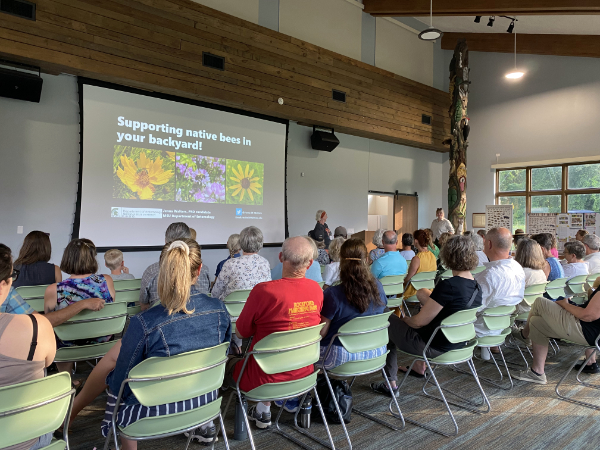

There was a good crowd that came to Roselle Park on August 21, to hear Jenna Walters speak about native bees. Jenna is a PhD Candidate from the MSU Department of Entomology and Ecology, Evolution, and Behavior.
Jenna started her presentation showing the difference between bees, flies, and wasps. Some defining characteristics of wasps are that they have a thin, narrow waist while bees are thick-bodied. Flies have large eyes on top of their heads—bees have eyes on the sides of their heads. She then showed various photos and had the audience identify them as bee, wasp, or fly.
We learned that there are 20,000 described species of bees in the world! There are 7 bee families and only one, Stenotritidae, is not found in Michigan.

Jenna explained that social bees live in colonies while solitary bees, like ground nesting bees and cavity nesting bees, live alone.
What is the status of native bees in Michigan:
- 50% of bumblebee species now have much smaller ranges
- 46% of Megachile (leafcutter) species in decline
- The Rusty Patched bumblebee, Bombus affinis, has had endangered status since 2017.
Since 1990, native bee diversity has declined 25% globally. Invasive bees and managed bees have had an effect on native bee decline. Since 1961, there has been an 85% increase in honeybee colonies. “A 40-hive apiary residing on wild lands for 3 months collects the pollen equivalent of four million wild bees.” Honeybees are farmed insects and are considered livestock. They were brought over in the 1600s from Europe.
Since 2003, invasive non-native Mason Osmia species bee populations have increased 800% while the six native Mason Osmia species bees have shown a decline of 76–91%. This decline is directly connected to higher invasive populations.

What makes a yard bee friendly for native bees?
- Native plants that flower throughout the season (early Spring-late Fall)
- No pesticides sprayed – especially during bloom!!
- Create a muddy patch in a corner of your yard to provide water and mud to bees
- Be messy! Leave dead trees, broken or hollowed out stems, leaf piles, and bare patches of soil
Get involved with monitoring programs such as:
- iNaturalist
- Bumblebee Watch
- Great Sunflower Project
- Queen Quest
 Important Spring-blooming native plants/trees for bees:
Important Spring-blooming native plants/trees for bees:
- Dutchman’s breeches
- Jacob’s ladder
- Coreopsis lanceolata
- Virginia bluebells
- Chokecherry
- Willow
- American elderberry
- Basswood
 Important Summer-blooming native plants:
Important Summer-blooming native plants:
- Bee balm
- Purple coneflower
- Smooth oxeye sunflower
- Black-eyed Susan
- Nodding onion
- Culver’s root
- Yellow coneflower
- Butterfly milkweed
 Important Fall-blooming native plants:
Important Fall-blooming native plants:
- New England aster
- Goldenrod
- White wood aster
- Blue wood aster,
- Black-eyed Susan
- Joe Pye weed
Jenna showed many beautiful slides of Michigan native bees (and their descriptions) and the native plants that support them. She was an engaging and enthusiastic—and at times—humorous speaker! (See photo below.) She showed her love for bees and frequently called bees “cute”. Thank you Jenna, for sharing your extensive knowledge with Wild Ones!
View/download Jenna Walters entire slide presentation here.

